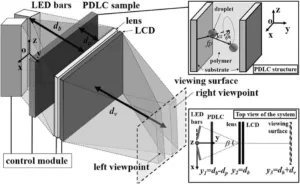A team of researchers led by Haiyu Chen at the State Key Laboratory of Optoelectronic Materials and Technologies, School of Physics, Sun Yat-sen University (Guangzhou, China) is developing a switchable 2D – autostereoscopic 3D display that includes the innovative use of a polymer dispersed liquid crystal (PDLC) film.
A recent article published by the team is entitled “A 2D/3D Switchable Directional-Backlight Autostereoscopic Display Using Polymer Dispersed Liquid Crystal Films.” It was published in the Journal of Display Technology, Vol. 12, No. 12, December 2016. A copy of the article is available here.
First, a few words of background information.
In a directional backlight based autostereoscopic 3D display, the illumination produced by the backlight needs to be transmitted through the LCD and proceed to the viewer with minimal scattering. This is necessary to preserve the directionality of the illumination needed to minimize crosstalk between the images seen by the viewer’s left and right eyes. A consequence of this approach is that a high quality 3D image is provided at a series of discrete “sweet spots.” The point to note is that these sweet spots exist not only when the display is in the 3D mode but also when the display presents a 2D image.
The problem is that, in the 2D mode, a quality image is expected not just at sweet spots but, rather, to be uniformly excellent over a wide viewing angle. This required a backlight that produces a more diffuse illumination. One means to address this issue is to make a backlight that is capable of switching between an operating mode optimized for 3D viewing and a mode that is optimized for 2D viewing.
One approach to the design of such a backlight involves the incorporation of a switchable scattering component. The specific switchable component investigated by the researchers was a PDLC film. This type of film can switch between a transparent state when a voltage is applied and a scattering state when no voltage is applied. By this means, the powered film can be almost transparent when the display is in the autostereoscopic 3D mode and the highly scattering, unpowered PDLC film can be used to disrupt the directionality of illumination when the display is in the 2D mode.
In their paper, the researchers analyzed propagation of light within the 2D/3D switching system utilizing a Monte Carlo ray-tracing method. They then went on to build a prototype for measurement of 3D display quality with PDLC film in transparent state and 2D uniformity with the film in the scattering state. The prototype system is illustrated in the figure below.
The team’s recent scientific article reports that the simulation curves fit the experimental results quite well. A great deal of detailed information and complete results can be found in the article. Top level experimental results show that:
- In the 3D mode, the PDLC film in its transparent state did not cause deterioration to the high quality of the autostereoscopic 3D image. There was some decrease in luminance but the crosstalk was kept to below 3%. The scattering PDLC film was found to minimize discontinuities between the 3D viewing sweet spots.
- In the 2D mode, the PDLC film in its scattering state produced an adequately uniform image within the angular viewing range. “According to the measured results of different PDLC samples, it is estimated that the haze of the film should be over 60% to achieve sufficient uniformity. It is also indicated that there is a negative correlation between luminance and uniformity. To compensate for the luminance attenuation, increasing the driving duty cycle of LED bars is a simple and valid method.”
The researchers comment that their most recent work was based on a specific configuration switchable 2D – autostereoscopic 3D display. None-the-less, they feel that it should be possible to extend the use of a PDLC film as a 2D/3D switch to other types of autostereoscopic display systems also based on a directional backlight. – Arthur Berman
Sun Yat-sen University, Haiyu Chen, [email protected]

